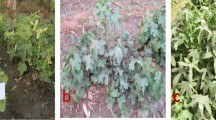Abstract
Cross-compatibility behaviour of doubled haploid (DH) and hybrid genotypes of Coffea camphora was established using both phenotypic bioassay and in situ seed-set examination. The availability of DHs provided the opportunity of working with genetically homogenous pollen and female parents. The aniline blue fluorescence (ABF) method was applied to detect callose accumulation in pollen and pistil. Clear cross-compatibility/incompatibility situations were observed and confirmed by in situ seed-set analysis. Cross-compatibility analysis of hybrid combinations involving different DHs corroborated the crossing behaviour observed at the DH level. Expression of the self-incompatibility system did not appear to be affected by the low vigour of the DH. The crossing-behaviour distribution observed within DHs derived from clone IF200 confirmed that self-incompatibility in C. canephora is a gametophytic self-incompatibility system controlled by a single locus (S-locus). Reduced seed-set developments following incompatible crosses may indicate the occurrence of pseudo-incompatibility. Molecular marker linkage analysis showed that the S-locus is associated with an RFLP marker on linkage group 9. The availability of a linked DNA marker should facilitate the genetic analysis of self-incompatibility in relation to coffee breeding programmes.
Similar content being viewed by others
References
Ascher P (1976) Self-incompatibility systems in floricultural crops. Acta Hortic 63:205–215
Berthaud J (1980) L'Incompatibilité chez Coffea canephora: méthode de test et determinisme génétique. Café Cacao Thé 24:267–274
Berthaud J (1986) Les ressources génétiques pour l'amélioration des caféiers africains diplöides. In: Collection “Travausx et Documents”, No. 188, ORSTOM, Paris
Bridson DM, Verdcourt B (1988) In: Polhill RM (ed) Flora of tropical East Africa — Rubiaceae (part 2). Brookfield, Rotterdam, pp 1–227
Charlesworth D (1985) Distribution of dioecy and self-incompatibility in angiosperms. In: Greenwood PJ, Harvey PH, Slatkin M(eds) Evolution: essays in honour of John Maynard Smith. Cambridge University Press, Cambridge pp 237–268
Charrier A, Berthaud J (1985) Botanical classification of coffee. In: Clifford MN, Wilson KC (eds) Coffee: botany, biochemistry and production of beans and beverage. Croom Helm, London, pp 13–47
Conagin CHTM, Mendes AJT (1961) Pesquisas citologicas e geneticas em tres especies de Coffea. Auto-incompatibilidade em Coffea canephora. Bragantia: 787–804
Devreux M, Vallayes G, Pochet P, Gilles A (1959) Recherches sur l'autostérilité du caféier robusta (C. canephora Pierre). Publication INEAC, Série scientifique 78
Dumas C, Knox RB (1983) Callose and determination of pistil viability and incompatibility. Theor Appl Genet 67:1–10
Hayman DL, Richter J (1992) Mutation affecting self-incompatibility in Phalaris coerulescens Desf. Heredity 68:495–503
Lander ES, Green P, Abrahamson J, Barlow A, Daley M, Lincoln S, Newburg L (1987) MAPMAKER: an interactive computer package for constructing primary linkage maps of experimental and natural populations. Genomics 1:174–181.
Larsen K (1977) Self-incompatibility in Beta vulgaris L. I. Four gametophytic, complementary S-loci in sugar beet. Hereditas 85:227–248
Lashermes P, Couturon E, Charrier A (1994a) Doubled haploids of Coffea canephora: development, fertility and agronomic characteristics. Euphytica 74:149–157
Lashermes P, Couturon E, Charrier A (1994b). Combining ability of doubled haploids of Coffea canephora. Plant Breed 112:330–337
Levin DA (1985) Reproductive character displacement in Phlox. Evolution 39:1275–1281
Linskens HF, Esser K (1957) Über eine spezifische Anfärbung der Pollenschläuche in Griffel und die Zahl der Kailosepfropfen nach Selbstung und Fremdung. Naturwissenschaften 44:16
Louarn J (1992) La fertilité des hybrides interspécifiques et les relations génomiques entre caféiers diploïdes d'origine africaine (Genre Coffea L. sous genre Coffea). Thesis, Université d'Orsay, Paris XI
Martin FW (1959) Staining and observing pollen tubes in the style by means of fluorescence. Stain Technol 34:125–128
Nettancourt D de (1977) Incompatibility in angiosperms. Springer, Berlin Heidelberg New York
Newbigin E, Andersen MA, Clarke AE (1993) Gametophytic self-incompatibility systems. Plant Cell 5:1315–1324
Osterbye U (1975) Self-incompatibility in Ranunculus acris L. Genetic interpretation and evolutionary aspects. Hereditas 80:91–112
Paillard M, Lashermes P, Pétiard V (1996) Construction of a molecular linkage map in coffee. Theor Appl Genet (in press)
Thompson MM (1979) Incompatibility alleles in Corylus avellana L. cultivars. Theor Appl Genet 55:29–33
Author information
Authors and Affiliations
Additional information
Communicated by H. F. Linskens
Rights and permissions
About this article
Cite this article
Lashermes, P., Couturon, E., Moreau, N. et al. Inheritance and genetic mapping of self-incompatibility in Coffea canephora Pierre. Theoret. Appl. Genetics 93, 458–462 (1996). https://doi.org/10.1007/BF00223190
Received:
Accepted:
Issue Date:
DOI: https://doi.org/10.1007/BF00223190




